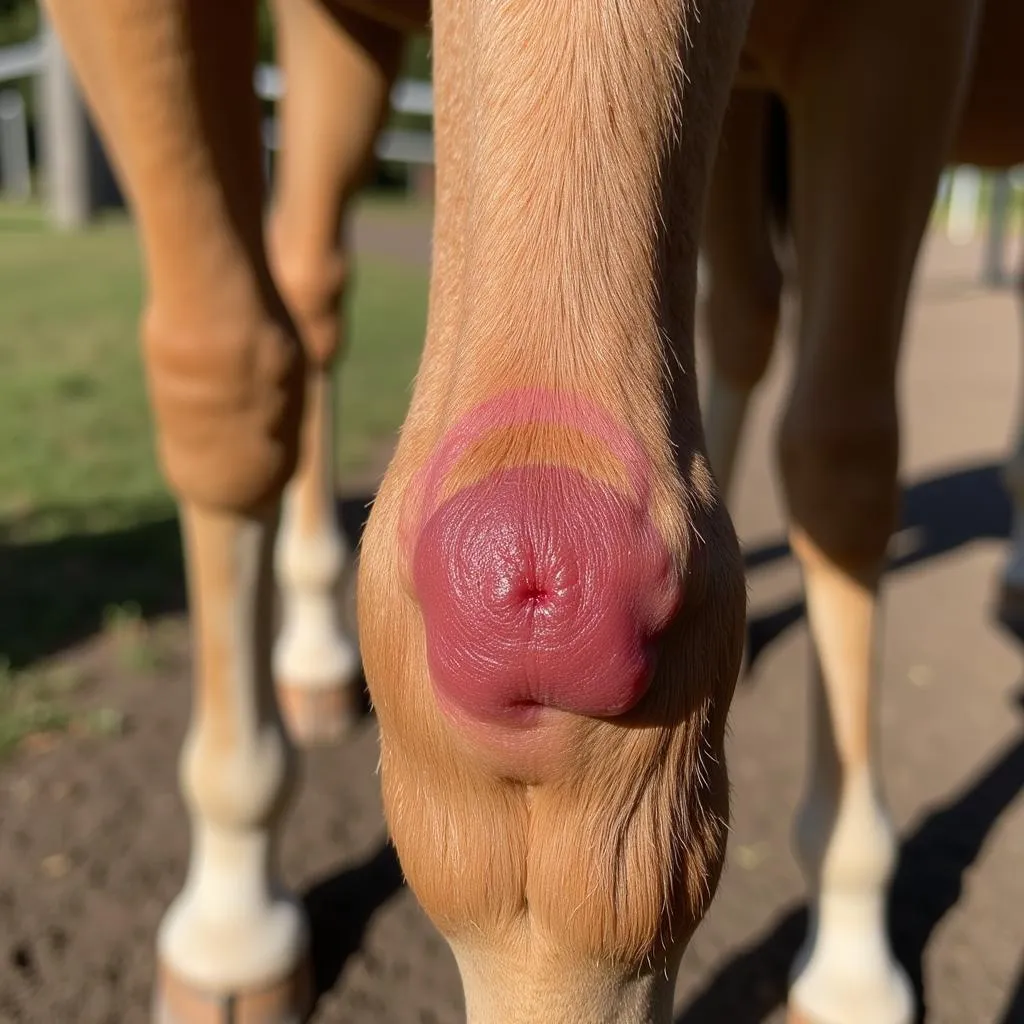A fluid lump between a horse’s front legs can be alarming for any horse owner. While not always a cause for panic, it’s essential to understand the potential causes and know when to seek veterinary attention. This article will guide you through the possible reasons for a fluid lump in this location, how to identify the underlying issue, and the appropriate steps to take for your horse’s health.
Understanding the Location and Potential Causes
The area between a horse’s front legs, technically known as the pectoral region, houses several vital structures. A fluid lump in this area could indicate various conditions, ranging from relatively benign to serious:
1. Insect Bites and Allergic Reactions
One of the most common causes of fluid-filled lumps, particularly during warmer months, is insect bites.  Horse Leg with Insect Bite Mark Horses can be sensitive to various biting insects, and their immune response may manifest as localized swelling. Similarly, allergic reactions to plants, medications, or other environmental factors can also lead to fluid-filled lumps.
Horse Leg with Insect Bite Mark Horses can be sensitive to various biting insects, and their immune response may manifest as localized swelling. Similarly, allergic reactions to plants, medications, or other environmental factors can also lead to fluid-filled lumps.
2. Abscesses
An abscess, a localized collection of pus within body tissue, can also present as a fluid lump. Abscesses are often painful and warm to the touch and may cause lameness. They typically occur due to a bacterial infection entering the skin through a wound, even a small one.
3. Hernias
While less common in the pectoral region, hernias can occasionally occur. A hernia develops when an internal organ or tissue protrudes through a weakness or opening in the surrounding muscle or tissue wall. Hernias between the front legs might involve abdominal contents pushing through the chest wall.
4. Tumors
In rare cases, a fluid lump between the front legs could be a tumor. These growths can be benign (non-cancerous) or malignant (cancerous) and require veterinary diagnosis and treatment.
Identifying the Problem: Signs and Symptoms
Noticing a lump between your horse’s front legs is just the first step. To determine the cause and appropriate action, pay attention to these additional signs and symptoms:
- Size and Shape: Is the lump small and round or large and irregularly shaped?
- Texture: Is it soft and yielding or firm and immobile?
- Temperature: Is the lump hot to the touch compared to the surrounding skin?
- Pain: Does your horse show signs of pain when the area is touched, such as flinching, pinning ears, or biting?
- Lameness: Is your horse lame or reluctant to move, particularly on the affected leg?
- Other Symptoms: Note any other changes in your horse’s behavior, appetite, or overall health.
When to Call the Veterinarian
It’s crucial to contact your veterinarian immediately if you notice any of the following:
- Sudden onset of a large, painful lump
- Severe lameness or reluctance to move
- Signs of systemic illness, such as fever, lethargy, or loss of appetite
- Discharge or open wounds in the area of the lump
- The lump continues to grow or doesn’t improve within a few days
Diagnosis and Treatment
Your veterinarian will likely perform a physical examination and may recommend additional diagnostics to determine the underlying cause of the fluid lump. These may include:
- Aspiration: Using a needle to extract fluid from the lump for analysis to check for infection or abnormal cells.
- Ultrasound: Using sound waves to create images of the tissues and structures beneath the skin, which can help identify abscesses, hernias, or tumors.
- Blood work: To check for signs of infection or other systemic issues.
Treatment will depend on the underlying cause of the fluid lump. Options might include:
- Drainage and flushing: For abscesses, your veterinarian will lance and drain the pus, followed by flushing the area with an antiseptic solution.
- Medications: Antibiotics may be prescribed for bacterial infections, while anti-inflammatory drugs can help reduce pain and swelling.
- Surgery: Surgical intervention may be necessary for hernias or tumors.
“Early detection and intervention are key,” says Dr. Sarah Miller, a leading equine veterinarian. “The sooner you address a fluid lump, the better the outcome for your horse.”
Prevention is Key
While not all causes of fluid lumps are preventable, some measures can reduce the risk:
- Maintain a clean and dry environment for your horse.
- Practice good fly control. Use fly spray, masks, and sheets during peak insect season.
- Regularly inspect your horse for injuries. Promptly clean and disinfect any wounds.
- Schedule routine veterinary checkups.
Conclusion
Discovering a fluid lump between your horse’s front legs can be concerning, but understanding the potential causes and recognizing when to seek veterinary care can make a significant difference in your horse’s well-being. By being proactive and informed, you can help ensure your equine partner receives the appropriate treatment and enjoys a happy, healthy life.
Have questions or need assistance with your horse’s health? Contact us! Our dedicated team is available 24/7 to provide support and guidance. Call us at 0772127271, email us at [email protected], or visit us at QGM2+WX2, Vị Trung, Vị Thuỷ, Hậu Giang, Việt Nam.